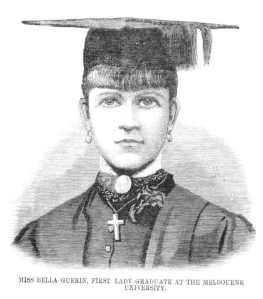The Irish influence on Ballarat
“Gentlemen and savages – Men of Ballarat and fellows of Bungaree” These were just some of the inflaming words spoken by the controversial Victorian politician C. E. Jones, at a political meeting in Ballarat, 1864. Jones was attempting to trade on the popular Old World idea of the Irish as lower-caste, illiterate and priest-ridden trouble makers who were intent on lowering the standards of this new society in Ballarat. In fact these ideas about the Irish presence in Ballarat were completely inaccurate.
The Irish were the second largest national group (the largest being the English), to influence the history of Australia during the gold rush and colonial periods. From 1851 to 1901 the percentage of the population considering themselves Irish remained at around 20%. Most of these immigrants came from the southwest counties of Clare, Tipperary, and Galway.
The majority of Irish immigrants to Australia arrived after the discovery of gold in 1851. Before this time, during the period known as the Great Famine, only about 2% of Irish emigrants came to Australia (about 23,000). In the first decade of Australia’s gold rush (1851 – 60), about five times that number came to Victoria (101,540 or 8%), in the next decade it was 10% and in the 70’s rose to 11.4%. (“In 1846, 9,000 – or one quarter of the population of Victoria – was Irish born.” – Eric Clancey – The Overflow of Clancey Chapter 2)

St Alipius tent school, by Eugene Von Guerard. Ballarat Historical Society Collection. Ballarat Gold Museum.
Gold wasn’t the only reason that Irish people immigrated to Australia, the possibility of taking up land also drew many here. Patrick O’Farrell claimed that the Irish came “in search of gold land, fortune and adventure: they were a much more accomplished, venturesome and happy lot than those the Famine had dumped on America.” Up until the 1860’s Irish immigrants were generally younger than other British immigrants, and they were mostly bachelors and spinsters. The men generally described themselves as labourers and the women as domestic servants. Many were illiterate and most were Catholic. As a result of this, the Catholic Church and schools in Victoria were also mainly populated by Irish Catholics. St Alipius Parish School was the first school opened on the Ballarat diggings for Catholic children. Father Patrick Dunne was the first priest to celebrate mass on the diggings in October 1851. In late 1852, Father Matthew Downing arrived on the Ballarat goldfields and named his Parish after St Alipius and the Bishop of the time, James Alipius Goold. In February 1853 Father Downing moved to the present St Alipius site and erected a large tent chapel, reinforced with slabs. This not only became a landmark on Victoria Street, watching over the Eureka diggings, but also served as the first school for Catholic children. Classes for boys and girls began on 1 April and were taught by lay teachers. Sovereign Hill has kept the history of St Alipius School alive by recreating the tent structure and incorporating it into the Costumed
School Program. The first woman to graduate from a University in Australia, Bella Guerin, taught at Loreto College, a Catholic Girls School in Ballarat in 1885. Bella had spent her earlier years in Ballarat, living at the gaol where her father was governor.
Many of the Irish immigrants came to Australia with deep seated feelings of injustice from their treatment by the English back in the “homeland”, and some of them became involved in events that would later be described as “rebellious” by critics. The Eureka Stockade is one example of this “blame it on the Irish” mentality. Although many Irish people were involved in the protests and meetings preceding the Eureka battle, and many of the casualties were of Irish
descent, it would be wrong to conclude that they were just Irish troublemakers as people of many other nationalities were also heavily involved in these events.
The Irish also tended to live in clusters. Around Ballarat, this meant there were large populations around Bungaree and Dunnstown for example. This is why Mr Jones was able to generalise about the “savages of Bungaree”. Much like the other British immigrants to Victoria, the Irish tended to alter the rural landscape around them to remind them of “home”. Their great love of Ireland enabled them to bring a sense of their homeland with them to Ballarat, possibly more than any other Celtic group.
Despite the clusters of rural populations, some did stay closer to Ballarat, and many became quite successful businessmen and leaders in the community. Among these people were Peter Lalor, Sir Henry Cuthbert, Edward Murphy, Anastasia Hayes and James Coghlan. Coghlan was a founder of the Phoenix Brewery, which thrived for many years in Ballarat. These successful men
ensured that StPatrick’s Cathedral in Ballarat was built, at a cost of £27,000. These men did not only build churches. They also developed businesses and built many other buildings, including a large number of hotels. Interestingly, a survey of 1,853 hotel names from this period revealed over 84 with Irish names.
There is still a very strong sense of Irish heritage amongst the people of Ballarat and surrounding districts. St Patrick’s Day is still celebrated in the city and many of the smaller farming communities around Ballarat, and many of the people of these areas will still proudly claim their Irish heritage, even though they may be fourth or fifth generation Australian born.
For more information on the Irish in Ballarat try these links:
Identifying the Irish in Ballarat












This is a fascinating account of the history of our district’s settlement by the Irish
Thanks Jeremy- I’ll pass that message on to Pete B.